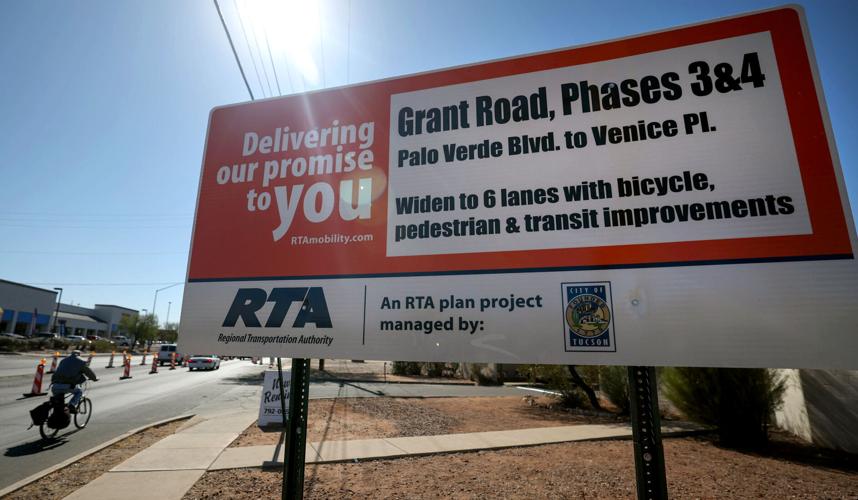There’s not enough money to pay for the final phases of Tucson’s ongoing Grant Road widening project nor to start long-awaited improvements to North First Avenue, transportation officials say.
There’s a roughly $146 million funding gap for the two projects, the Regional Transportation Authority Board says. The projects are part of major transportation projects across the Tucson area that Pima County voters approved in 2006.
Four major voter-approved RTA projects for Tucson have already been moved from the current list of work to a major regional transportation plan called RTA Next that is set to go to voters next year, says Tim Thomure, Tucson’s city manager. The four deferred projects: North First Avenue from East Orange Grove to East Ina roads; North Houghton Road from East Broadway to East Tanque Verde Road; North Silverbell Road from West Camino del Cerro to West Ina Road, and 22nd Street from Interstate 10 to South Kino Parkway.
“It’s really the first time that we’ve heard publicly that there is not enough money to complete all of the projects in the current plan,” Sam Credio, director of the city’s Department of Transportation and Mobility, told the Tucson City Council at its Oct. 22 meeting.
Farhad Moghimi, executive director the nine-member governing body of elected officials from the region’s cities, towns and tribal communities that oversee major transportations project here, pushed back on Credio’s claim in an interview, telling the Tucson Sentinel the RTA board has “talked about it at every meeting” for the last five years.
But councilman Kevin Dahl says the first he heard of the funding gap was from Credio during last month’s council meeting. Both the Grant Road and First Avenue projects are in his ward.
“Frankly, I’m not surprised. The last year, I’ve been very critical of leadership at RTA ... I have very little confidence in the management of RTA based on the lack of communication and the leadership style,” Dahl told the Star. “I’m not confident going into RTA Next, and I’m not confident that we’re going to be able to finish the (current plan) as promised.”

A funding shortfall could mean the final phases of Tucson’s Grant Road widening project won’t be completed, officials say.
A funding shortfall could mean the final phases of Tucson’s Grant Road widening project won’t be completed, officials say.
The RTA Board, the nine-member governing body of top elected officials from the region’s cities, towns and tribal communities, recently voted to bring the second iteration of the plan, dubbed RTA Next, to a vote in November 2025.
If passed by county voters, the $2.46 billion RTA Next plan would go into effect in April 2026. The RTA also scheduled 13 open house events through the end of this year to go over the plan.
Pima County voters ultimately will decide if they want to move forward with another 20-year, half-cent sales tax, Dahl said. But he added that RTA Next does not do enough for the city, nor his constituents.
“I need to see better leadership at RTA (for it to gain my support),” he said. “I represent 90,000 people, which is bigger than any of the other entities on RTA. ... I think regional planning is the bee’s knees, that’s the way we should go. But when it’s stacked against the majority of the voters in that regional area, then it’s not the way to go.”
Pima County voters in 2006 approved a half-cent sales tax over a 20-year span to fund $2 billion worth of transportation projects. But revenue came in much lower than expected. By August of last year there was an estimated $500 million shortfall to complete projects promised to voters, the Star has reported.
“I was just shocked to learn that they’re going to go to the public, asking for the next allocation of money, (while) having no way of knowing how they’re going to finish two major projects in Ward 3,” Dahl told the Star. “To hear that the city is going to have to fill the gap, and then the city has to support an RTA Next, where the city is not getting the same percentage of expenses that equals the revenues that our taxpayers are going to be paying ... c’mon. It’s two strikes.”
Credio told the council there’s been no “additional clarity on how that funding gap will be shored up in the near-term,” for Grant Road or First Avenue.
“The only strategy that’s been offered,” city manager Tim Thomure added, “is ‘cities: go figure it out.’”
Councilwoman Nikki Lee called the situation “B.S.” She said the city doesn’t have millions of dollars “laying around to finish these projects.”
“This really needs to be an important part of the conversation, especially if we expect the public to have faith in the second RTA,” Lee said.

A funding gap could mean the final phases of ongoing improvements to East Grant approved by voters in 2006 won’t get done, officials say.
The Grant Road widening project, included in the 2006 plan, generally spanned from west of North Oracle to North Swan roads and was divided into six construction phases. Phase 1 revamped the Oracle-Grant roads intersection and was completed in 2013. Phase 2 generally spanned Grant between North Stone and North Park avenues; and was completed in October 2018. The final four phases were to be completed in sets of two. Phases 3 and 4 began in May and are still underway; it generally spans Grant between North Alvernon Way and North Swan Road.
But what’s at issue is a lack of funding for the final two phases of Grant, spanning generally from North Mountain Avenue to North Sparkman Boulevard, which is between North Country Club Road and North Dodge Boulevard.
In addition to widening the road to six lanes, a raised median was to be installed with buffered bike lanes, five- to eight-foot sidewalks and, among other features, indirect left turn lanes at the intersection of Grant and North Campbell Avenue, a particular sore spot for midtown commuters.
The First Avenue corridor project, also included in the voter-approved 2006 plan, would span from Grant to East River Road.
It would include “a new bridge over the Rillito River, pavement reconstruction, continuous and accessible sidewalks, enhanced bicycle facilities, safety improvements, drainage improvements, upgraded traffic signals, and landscaping,” according to the project’s website.
Construction of the up to two-year project was expected to begin in 2027-28.





